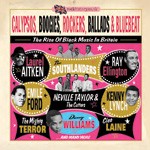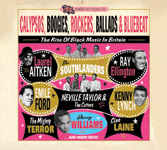 The Rise Of Black Music In Britain
The Rise Of Black Music In Britain
In 1948, the Empire Windrush famously docked at Tilbury, carrying 493 passengers from Jamaica and Trinidad (plus, by all accounts, one stowaway!). Pathe News were among the media gathered there to meet them, and a remarkable piece of newsreel footage survives in which the freshly disembarked King Of Calypso, Lord Kitchener, serenades everyone with impromptu version of ‘London Belongs To Me’. And although this by no means marked the birth of black music in the UK (it wasn’t even the first boat-load of migrants from the West Indies – a smaller vessel, the Almazora, had delivered some 200 Jamaican passengers to Southampton six months earlier), the symbolic landing of the Windrush is very much seen as a rallying point for much of what would follow, socially, artistically and musically.
At that time a handful of black performers were already carving out successful careers in the UK, albeit, all following rather different musical paths. The suave, urbane Ray Ellington (real name, Henry Pitts Brown – his father was a black American Music Hall comedian/entertainer, his mother an orthodox Russian Jew) had drummed and sung in Harry Roy’s band, both before and after WWII, eventually forming his own band circa 1948. Although essentially a jazz musician he was heavily influenced by Louis Jordan – hence his cover of ‘Let The Good Times Roll’ – and his was the first British band to feature the stripped-down guitar/bass/piano/drums format, which would in due course form the bedrock of Rock & Roll.
Conversely, Edric Connor was about as far removed from R&R as was possible. Arguably the most important UK-based black performer of the immediate post-war era, Connor arrived from Trinidad in 1944 and settled in London, where he established himself as a storyteller, writer, film-maker, singer, dancer and actor, and ultimately a respected ambassador for all aspects of Caribbean art and culture. He also enjoyed an unlikely hit record with ‘Manchester United Calypso’; recorded in 1956, it entered the Melody Maker Top 20 in 1958, shortly after the Munich air disaster.
Winifred Atwell, meanwhile, had established herself as the most successful British-based black entertainer of the 50s, selling literally millions of 78 rpm records. The classically-trained pianist had arrived from Trinidad in 1946, via the United States, and began playing jazz and ragtime in the clubs, to fund her ‘serious’ musical studies. However it was her rags and boogies that would define her, musically, and in 1954 she became the first female artist to top the UK charts. She scored her biggest hit, ‘The Poor People Of Paris’, a couple of years later, by which time she was the highest-earning star in the UK, with her own TV show.
By the mid-50s several Calypso singers had become established in the UK, many of whom recorded for Nixa, the first British record company of any significance to regularly record Caribbean music. Apart from the aforementioned Lord Kitchener (aka Aldwin Roberts), Ben Bowers, Lord Invader (real name, Rupert Grant), Lord Ivanhoe (aka Clinton George) and The Mighty Terror (Fitzgerald Henry) were all hugely popular, their topical and/or double entendre-laden ditties readily reaching an audience outside their traditional immigrant markets. Similarly, a number of specialist jazz musicians – like alto sax hot-shot Joe Harriott and singers Bertice Reading and Cleo Laine – also began to reach wider audiences, the latter eventually going on to register a Top 5 hit in 1961 with ‘You’ll Answer To Me’.
In the area of more mainstream Popular music, The Southlanders have long since proved to be the most durable British vocal group, in terms of longevity. Formed in 1953 by Edric Connor, initially to back him on an LP of ‘negro spirituals and calypsos’, he encouraged the group to stay together, providing them with both inspiration and financial support. They charted with ‘Alone’ in 1957, but remain best known for the immortal ‘Mole In The Hole’. However, there can be no real doubt that Shirley Bassey remains the most celebrated and successful black British singer. After emerging from Cardiff as a teenager in the mid-50s, her first record, ‘Burn My Candle’ was banned by the BBC, but during 1959 she finally established herself with ‘Kiss Me, Honey Honey, Kiss Me’ and ‘As I Love You’, the latter becoming her first No.1 record.
The Rock & Roll era saw the arrival of Neville Taylor & The Cutters and Cuddly Dudley (aka Dudley Heslop), who were regulars on TV shows like Oh Boy!, Boy Meets Girls, and Drumbeat, although they were sadly unable to convert their popularity as live performers to record sales. However, Emile Ford & The Checkmates announced their arrival at the back end of 1959 with the chart-topping ‘What Do You Want To Make Those Eyes At Me For?’, one of the first discs to sell a million copies in the UK alone. Emile (born Michael Emile Telford Miller in St Lucia) was very much a reluctant Pop star, as he didn’t regard himself as a ‘proper’ singer; but he hit big again with ‘On A Slow Boat To China’, among others, and went on to achieve particular success in Scandinavia.
After getting his recording career under way in 1960, cheeky, chirpy Cockney Kenny Lynch made the Top 30 in 1962 with ‘Puff (Up In Smoke)’ and a cover of The Drifters’ ‘Up On The Roof’ (the latter making the Top 10), before going on to carve out a long, successful career. Similarly, South African-born Danny Williams – often billed as Britain’s Johnny Mathis – had a half-dozen or so singles released before finally hitting the jackpot with ‘Moon River’, which topped the charts in 1961. Considerably less fortunate were Joe Meek discovery Ricky Wayne, who registered a near-miss with ‘My Chick A’Roo’, and ex-American G.I. Davy Jones, who nowadays remains chiefly famous for his tenuous Beatles connection (he topped the bill over them at both The Cavern and The Star Club).
Derry Wilkie, from Toxteth, could boast an even stronger Beatle connection – Derry & The Seniors were the very first Scouse beat group to play the German club scene, paving the way for all who followed – whilst another UK-based former G.I. around this time was R&B singer Ronnie Jones, who joined Alexis Korner’s Blues Incorporated towards the end of 1962. But one of the strongest home-grown releases that year was The Chariots’ sole outing on the Piccadilly label, ‘Problem Girl’/‘Song Of A Broken Heart’. In hindsight, it seems inconceivable that (a) it wasn’t a hit, and (b) no more was ever heard from this group.
By the early 60s, Jamaican music was beginning to make its powerful presence felt on the British club scene, and sales of mysterious Bluebeat and Ska records were booming. Melodisc were the first UK record company to exploit this market, and they soon began bringing Jamaican artists to the UK to record. The first of these was The Godfather of Ska himself, Laurel Aitken, who was in turn followed by Errol Dixon, Bobby Kingdom, Azzie (sometimes Aizie) Lawrence, Girl Satchmo and Mel Turner, among others.
Sales of certain releases on the Bluebeat label were massive, sometimes in their tens of thousands. But as none were through chart return record shops, you won’t find any of them listed in the Guinness Book Of Hit Singles!

